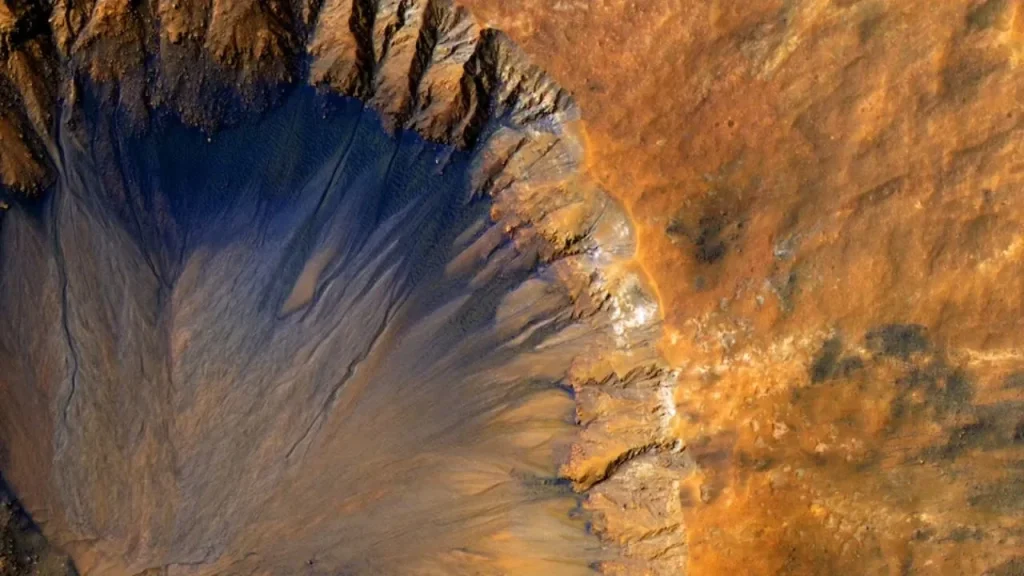The fourth planet from the Sun and the second-smallest planet in the solar system is Mars, sometimes referred to as the Red Planet. Because of its crimson hue—a result of iron oxide, or rust—on its surface, it is called after the Roman god of battle. There is still a lot to learn about this fascinating planet, Mars (interesting facts about Mars), which has long captivated the attention of astronomers and scientists.
In this post, we’ll look at several intriguing Mars-related facts or interesting facts about Mars.
- First, Mars has two tiny moons. Phobos and Deimos, two minor moons of Mars, are thought to be asteroids that collided with the planet. Deimos has a diameter of around 12.4 kilometers (gravity on Mars), whereas Phobos has a diameter of approximately 22.2 kilometers, making it the bigger of the two moons. Both moons have many craters and an uneven form (universe space). They have the names of the sons of Ares, the ancient Greek representation of Mars (interesting facts about Mars).
- The solar system’s biggest volcano is found on Mars (fun facts about Mars). Olympus Mons, the biggest volcano in the solar system, is located on Mars. Its height is 22 kilometers, and its base is 600 kilometers in diameter, making it roughly three times as tall as Mount Everest. As a shield volcano (universe space), Olympus Mons has a broad, gentle slope created by numerous lava flows (interesting facts about Mars). Despite being estimated to be 2.5 billion years old, it is still regarded as an active volcano.

- The solar system’s longest canyon is on Mars (interesting facts about Mars). Valles Marineris is a canyon on Mars that is the longest in the solar system. It is up to 200 kilometers wide, over 4,000 km long, and up to 7 kilometers deep. It was given the Mariner 9 spacecraft’s name following its 1971 discovery. Instead of being eroded by water like Earth’s canyons, Valles Marineris was created by tectonic action.
- A chilly, dry planet is Mars. About one hundred times less thick than Earth’s atmosphere, Mars’s is thin (interesting facts about Mars). The outcome is a frigid environment on Mars because of the planet’s extremely limited greenhouse effect. On Mars, wintertime temperatures may reach -143 degrees Celsius at the poles and a mean of roughly -63 degrees Celsius throughout. The martianHaving only trace amounts of water vapour in its atmosphere, Mars is also a very dry planet. Deserts, rocky (interesting facts about Mars).
- The poles of Mars have ice caps. Mars has polar ice caps that are composed of water and carbon dioxide, despite the fact that it is a dry planet. With a circumference of around 1,000 kilometers and a volume of 1.6 million cubic kilometers, the northern ice cap is rather large. Only 80,000 cubic kilometers of ice make up the southern ice cap, which is smaller. On Mars, the polar ice caps are known to periodically move and alter throughout time and are not entirely solid (interesting facts about Mars).
- The atmosphere of Mars is thin. Carbon dioxide dominates the thin atmosphere of Mars, with traces of nitrogen and argon. Life on Mars has a difficult time surviving since the planet’s tiny atmosphere is unable to shield it from dangerous solar radiation (interesting facts about Mars). The low atmosphere on Mars does, however, give it a perfect place to conduct research on the planet’s surface and atmosphere.
- The day on Mars is about the same duration as the day on Earth (interesting facts about Mars). A Martian day, or sol, is roughly 24 hours and 39 minutes long because Mars revolves on its axis at a speed close to that of Earth. This makes it simple for researchers to employ timekeeping methods from Earth to examine Mars. Nevertheless (interesting facts about Mars), Mars takes a lot longer than Earth to orbit the Sun, with one Martian year lasting around 687 Earth days.
- Numerous spacecraft have investigated Mars. NASA, the European Space Agency, and the Russian Space Agency are just a few of the space agencies that have conducted several missions to Mars (interesting facts about Mars). A few conspicuous absences include the Viking program from the 1970s, which was the first successful attempt to land a spacecraft on Mars and perform experiments there, and the Spirit and Opportunity Mars rovers, which spent more than a decade exploring the Martian surface. Mars is currently being explored by a number of projects, including NASA’s Mars 2020 mission, which consists of the Perseverance rover and the Ingenuity helicopter.
- Numerous spacecraft have investigated Mars. NASA, the European Space Agency, and the Russian Space Agency are just a few of the space agencies that have conducted several missions to Mars (.fun facts about mars) A few conspicuous absences include the Viking program from the 1970s, which was the first successful attempt to land a spacecraft on Mars and perform experiments there, and the Spirit and Opportunity Mars rovers, which spent more than a decade exploring the Martian surface. Mars is currently being explored by a number of projects, including NASA’s Mars 2020 mission, which consists of the Perseverance rover and the Ingenuity helicopter.

- Humans have been fascinated by Mars for thousands of years. Since many ancient civilizations connected Mars with their gods of battle and fertility, the planet has always piqued human curiosity. The concept of Mars (interesting facts about Mars) as a viable place for human colonization has gained popularity in current science fiction. Exploring Mars and maybe even terraforming it to make it habitable for humans is becoming increasingly doable as technology develops.
Conclusion:
Mars is a fascinating planet with a variety of distinctive features. There is a lot to learn and explore about Mars, from its two tiny moons to its enormous volcano and the longest canyon in the solar system (interesting facts about Mars). Mars continues to be of interest to scientists and space organizations throughout the world despite its chilly, arid atmosphere. We may someday be able to uncover this planet’s mysteries and perhaps even make it livable for human existence as we continue to learn more about it.



